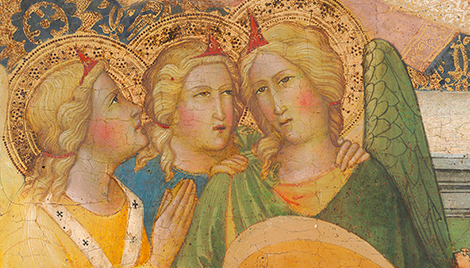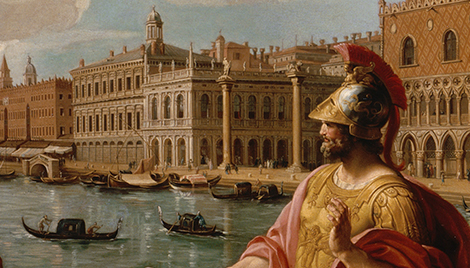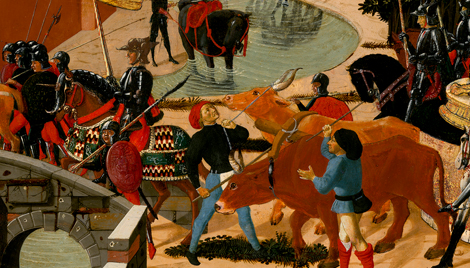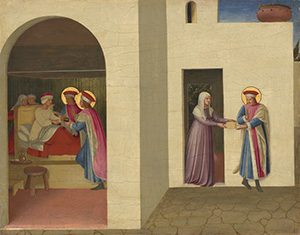The Healing of Palladia by Saint Cosmas and Saint Damian
The Healing of Palladia by Saint Cosmas and Saint Damian
- Artist
- Fra Angelico
- Artist Dates
- c. 1395-1455
- Artist Nationality
- Italian
- Title
- The Healing of Palladia by Saint Cosmas and Saint Damian
- Date
- c. 1438/1440
- Medium
- tempera and oil on poplar panel
- Dimensions
- painted surface: 36.2 x 46.3 cm (14 1/4 x 18 1/4 in)
- K Number
- K1387
- Repository
- National Gallery of Art
- Accession Number
- 1952.5.3
- Notes
Provenance
High altar of the church of San Marco, Florence, from about 1440 until about 1677. [1] Possibly in the passageway to the sacristy of the same church, by 1758,[2] or in the _Spezieria_ of the Convent of San Marco (recorded here in the early 19th century). [3] possibly in the Galleria dell'Accademia, Florence, after 1810-1812, and from here (if not directly from the _Spezieria_) in private hands. [4] James-Alexander, comte de Pourtalès-Gorgier [1776-1855], Paris, by 1841; (his sale, Hôtel Pourtalès-Gorgier, Paris, 27 March-4 April 1865, no. 86, as by Masaccio); probably Edmond [1822-1896] and Jules Huot [1830-1870] de Goncourt, Paris. [5] (Julius Böhler, Munich). [6] Albert Keller [1879-1939], New York, by 1924; (Duveen Brothers, Inc., London and New York); sold 1944 to the Samuel H. Kress Foundation, New York; [7] gift 1952 to NGA. [1] Vasari, in the second edition of his _Lives_ (1568), states that along with the main image, the predella of the altarpiece on the high altar of San Marco, representing "storie del martirio di San Cosimo e Damiano e degli altri" ("stories of the martyrdom of Saints Cosmas and Damian and of others"), is also the work of Fra Angelico; see Giorgio Vasari, _Opere_, ed. Gaetano Milanesi, 9 vols., Florence, 1878-1885: 2(1878): 508-509 (2nd ed. 1906, reprinted 1981, 1998). Another equally rare elaboration of the legend of the two saints was realized in Angelico's workshop in the so-called Annalena altarpiece (its main panel is now in the Museo di San Marco along with six elements of the predella; a seventh from the same series belongs to the Kunsthaus, Zurich; see John Pope-Hennessy, _Fra Angelico_, 2nd ed., London and New York, 1974: 211-212). The predellas of these two works have been confused in the literature (see note 4), but the one formerly completing the Annalena altarpiece cannot be related to the San Marco high altar because of the smaller size of the single scenes. It is now generally thought to be the work of an assistant, who has been identified as Zanobi Strozzi; see Licia Ragghianti Collobi, "Zanobi Strozzi Pittore," Part I: _CdA_ 22 (1950): 463-464. The San Marco altarpiece was probably removed for a restoration of the church that was to take place in 1678-1679. On the restoration, see Giuseppe Richa, _Notizie istoriche delle chiese fiorentine_, 10 vols., Florence, 1754-1762: 7(1758): 136. Already Giovanni Cinelli in his edition of Francesco Bocchi, _Le bellezze della città di Firenze_, Florence (1591), 1677: 16, reported that the old altarpiece had been moved to the Convent. [2] This location is indicated for the first time by Richa, _Notizie istoriche_, vol. 7 (1758): 143, and then by others up to Vincenzo Follini and Marco Rastrelli, _Firenze antica e moderna illustrate_, 8 vols., Florence, 1789-1802: 3(1791): 225; however, none mentions the predella. The old altarpiece was probably transferred to the passageway immediately after it was removed from the church, and it might have remained there until the suppression of the Dominican order in 1810. [3] Father Vincenzo Marchese, in his Memorie dei più insigni Pittori, Scultori e Architetti Domenicani, 2nd ed., 2 vols., Florence, 1854: 1:249, reports that "innanzi l'abolizione dei Conventi in Firenze erano nella Farmacia di San Marco sette tavolette dell'angelico rappresentanti...il martirio de'Santi Cosma e Damiano, e un'altra con la Deposizione di Croce dello stesso pittore" ("before the abolition of the Convents in Florence there were in the Pharmacy of San Marco seven panels by Angelico representing...the martyrdom of Saints Cosimo and Damian, and another with the Deposition from the Cross by the same painter"). It could be that among the "bellissimi quadri" ("beautiful pictures") that Cambiagi Gaetano (_L'Antiquario fiorentino o sia guida per osservar con metodo le cose notabili della città di Firenze_, Florence, 1765: 38) said could be seen in the _Spezieria_, there were also elements of the predella, already separated from the main altarpiece and divided into individual panels. The transfer of the panels into the _Spezieria_ is recorded also by a label glued to the back of the _Deposition_ in the Alte Pinakothek in Munich (WAF 38a) which reads: "Copia. Il quadro di Fra Angelico che si trova presso lo Speziale di St. M.co"; see _Briefwechsel zwischen Ludwig I von Bayern und Georg von Dillis_, 1807-1841, ed. by R. Messerer, Munich, 1966: 356. [4] Neither the panel now in Washington nor its companions were ever in the Saint Luke chapel in Santissima Annunziata, where in the early nineteenth century there were six panels with stories of the same saints; these, belonging to the Annalena altarpiece, entered the Gallereia dell'Accademia in Florence in 1854 (Galerie des petits tableaux, no. 22; see _Description des objets d'Art de la Royal Académie des Beaux-Arts de Florence_, 12th ed., Florence, 1854: 29) and were subsequently transferred to the Museo di San Marco. The author of the _Descrizione dell'Ie e R.e Accademia delle Belle Arti di Firenze_ , Florence, 1817: 22 n. 1; Maselli and Montani, 1832-1838, 307, n. 15; and other writers erroneously thought that six Cosmas and Damian panels then in Santissima Annunziata had originally belonged to the high altar of San Marco. The series that concerns us here probably stayed in the _Spezieria_ of San Marco only a short time. Already in 1813 the _Deposition_ now in Munich was sold by a group of persons who seem to have owned it jointly ("Das Bild von Fra Angelico... welches 14 Patronen hat.." ("the picture by Angelico, the property of fourteen persons"), as Georg von Dillis explained to the purchaser, Prince Ludwig of Bavaria; see Briefwechsel..., ed. Messerer, 1966: 356). The above-mentioned _Descrizione..._ (1817: 22, 24) reports that in the Galleria di Quadri Piccoli of the Accademia delle Belle Arti there were three "istorie di cinque Martiri" ("histories of five martyrs"), while the second edition of the same work (1827: 28) mentions only two, as do all the subsequent editions of the catalogue. These are _The Healing of the Deacon Justinian by Cosmas and Damian_ and _The Burial of the Two Saints and Their Three Younger Brothers_, now part of the collection of the Museo di San Marco. The third panel can probably be identified as _The Beheading of the Saints_ (Louvre, RF 340); on its back is a label dated 10 October 1817, according to which the work was transferred to the Accademia from San Marco and then given in exchange to a Prof. Nicola Tacchinardi (see Thomas Bodkin, "A Fra Angelico Predella," _The Burlington Magazine_ 58 [1931]: 188, 194). As for the remaining five panels, we have no record of their transfer to the Accademia, and like the _Deposition_, they apparently came onto the Florentine art market directly from the _Spezieria_ of San Marco. Marchese (1854: 249) states that this was the provenance of the four panels in the Alte Pinakothek in Munich (WAF 36-38 and WAF 38a) and identifies them as "quattro quadretti dell'Angelico, rappresentanti storie del martirio dei santi Cosma e Damniano, ch'erano a San Marco...in Germania" ("four little paintings by Angelico, representing stories of the martyrdom of Saints Cosimo and Damiano, which were in San Marco [and now are] in Germany"), which were apparently restored in Florence in 1817 by Luigi Scotti. Of the paintings in the series now in Munich, _The Saints before Lycias_, _Lycias Possessed by Devils_, and _The Saints Crucified_ reached their current destination only in 1827, and thus ten years earlier could still have been in Florence; see C. Syre, "Wirken Sie was Sie vermögen! Die Erwerbungen italienischer Gemälde in der Korrispondenz mit den Kunstagenten," _'Ihm, welcher der Andacht Tempel baut.' Festschrift zum Jubilaümsjahr 1986_, Munich, 1986: 49. The fourth painting restored by Scotti in 1817 must therefore have been a different one from the _Deposition_ by Fra Angelico, which was already in Munich in 1813. It might perhaps be _The Saints Saved from Fire_ now in the National Gallery in Dublin (no. 249), which in 1848 was still in Florence, in the collection of Francesco Lombardi and Ugo Baldi (see Giorgio Vasari, _Le vite de' più eccellenti pittori, scultori e architetti_, 14 vols., Florence, 1568, ed. Le Monnier, 1846-1879: 4[1848]: 28-29 note 4); but it could also be the Washington painting, which is mentioned for the first time in Paris, in the Pourtalès-Gorgier collection, only in 1841 (see Léon-Jean-Joseph Dubois, _Description des tableaux faisant partie des collections de M. le Comte de Pourtalès-Gorgier_, Paris, 1841: 3, no. 3, as by Masaccio). [5] A handwritten note with the name of the purchaser in the sale catalogue has been read as "de Zincourt" (Fern Rusk Shapley, _Catalogue of the Italian Paintings_, 2 vols., Washington, D.C., 1979: 1:9), although with a question mark. Ellis Waterhouse (written communication to the Gallery, 22 July 1980) suggests instead the reading "de Goncourt," referring, obviously, to the two Parisian novelists, critics, and collectors, who were great admirers of quattrocento painting. [6] Adolfo Venturi (_Studi dal vero: Attraverso le raccolte artistiche d'Europa_, Milan, 1927: 12) reports that the work used to belong to the art dealer Böhler, probably at the beginning of the 1920s; see also Fern Rusk Shapley, _Paintings from the Samuel H. Kress Collection: Italian Schools, XV-XVI Century_, London, 1966: 94. There does not appear to be a stock card for this painting among the Böhler Gallery records at the Getty Research Institute. [7] The painting has been hanging in the National Gallery since 1945, when it was still part of the Kress collection (see _Paintings and Sculpture from the Kress Collection_, National Gallery of Art, Washington, D.C., 1945 (reprinted 1947, 1959): 32).






